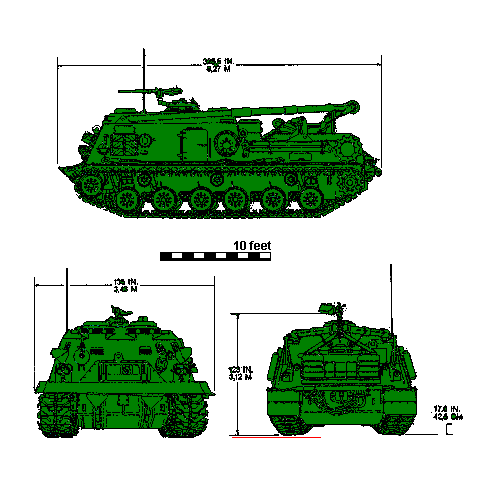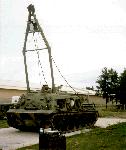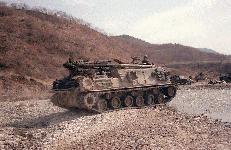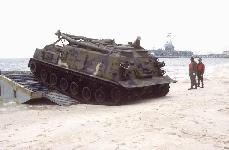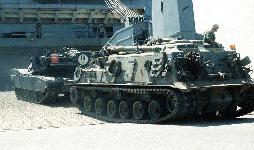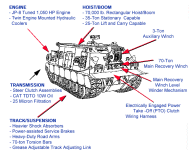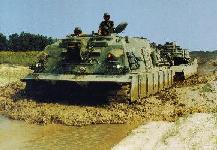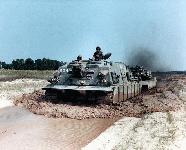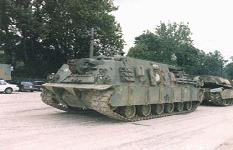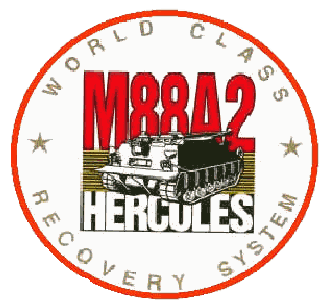 The M88A1 Medium Recovery Vehicle (MRV) is a full tracked armored vehicle used to perform battlefield rescue and recovery missions. The M88A1 MRV performs hoisting, winching, and towing operations supporting recovery operations and evacuation of heavy tanks and other tracked combat vehicles. It has a fuel/defuel capability and is fully equipped to provide maintenance and recovery support for the main battle tank family and similar vehicles. These functions can be performed in all types of terrain during all weather conditions.
The M88A1 Medium Recovery Vehicle (MRV) is a full tracked armored vehicle used to perform battlefield rescue and recovery missions. The M88A1 MRV performs hoisting, winching, and towing operations supporting recovery operations and evacuation of heavy tanks and other tracked combat vehicles. It has a fuel/defuel capability and is fully equipped to provide maintenance and recovery support for the main battle tank family and similar vehicles. These functions can be performed in all types of terrain during all weather conditions.
The existing M88A1 does not provide safe operation, braking, steering control or adequate power for recovery of the main battle tank. The M88A1, built for the preceding generation of M60 series tanks, are significantly outweighed by the 70-ton M1 tanks, a factor which severely limits the capabilities of the M88A1 in many types of terrain and situations. Due to weight differentials, two M88A1s are required to safely tow an Abrams series tank. The development of a new recovery vehicle began in August 1982 with the Ordnance Center and School (OC&S) identifying the need to develop an alternative which could support the Abrams fleet in terms of the mission requirements of recovery, towing and winching. A decision to build a new versus an improved vehicle was reversed several times, affordability being the constant issue. In August 1986, HQDA approved the strategy to develop a program around a product improvement to the M88A1.
M88A1E1 Improved Recovery Vehicle
The M88A1E1 Improved Recovery Vehicle was intended to replace the M88, which is unable to tow the newer, heavier M1A1 tanks. System improvements consisted of an upgraded power pack (engine and transmission), higher winch and hoist capacities, increased tow/breaking performance, and increased armor protection. The Hercules includes additional weight (approximately 70 tons), an upgraded suspension, power-assisted brakes, and an improved hydraulic system. The Hercules will possess an auxiliary power unit to operate no-load recovery components and impact tools without running the engine. Additionally, the Hercules will be transportable worldwide by highway, rail, marine, and air in accordance with the Military Traffic Management Command Transportation Engineering Agency (MTMCTEA) transportability engineering analysis. The M88E1 was cancelled to provide funding for the new M109A6 howitzer, though development of the M88A1E1 restarted in 1991. The M88A1E1 IRV was type classified as the M88A2.
M88A2 HERCULES
The M88A2 HERCULES Hercules [Heavy Equipment Recovery Combat Utility Lift and Evacuation System], formerly the M88A1E1 Improved Recovery Vehicle, addresses a long-standing US Army need to upgrade its recovery vehicles to safely tow and recover battle-damaged, mired or inoperative Abrams tanks. The HERCULES, using M88A1 hulls, modified to specification by Anniston Army Depot, upgrades the basic M88 chassis to meet the increased demands of towing, winching, and lifting the M1, M1A1, and M1A2 tank.
Among the most significant upgrades is its on-board recovery systems. The winch and hoist capacities are greatly increased to enable the vehicle to lift 40% heavier loads and winch 55% higher capacities. HERCULES features a longer 35-ton hoist capability boom, a 140,000 pound (63,504 kg) constant pull main winch with 280 feet (85.3 m) of cable and an auxiliary 3-ton winch to aid main winch cable deployment. The Hercules also incorporates improved hydraulics, enhanced propulsion system, and heavier suspension, along with overlay armor protection and ballistic skirts. The vehicle's enhanced survivability with added armor which brings its weight to more of a match for the Abrams tanks it predominantly supports. The HERCULES upgraded power train which enables it to tow a 25% larger load, with better braking capacity and higher speeds to better enable it to accompany maneuver forces. The crew has been reduced from four to three soldiers. This action results from some of the on-board innovations such as an auxiliary winch to deploy the main winch, chain/davit hoists for heavy equipment/machinery and a grease operated track adjuster.
M88A2 HERCULES ADVANTAGES
M88A2 Comparison to M88A1
-
Mobility
- Faster Speed, 24% With and 14% Without Towed Load due to Higher HP
- 20 - 25% Better in Braking Performance (Power Assist Brakes)
- 20 - 25% Better in Slope Performance
- – 25% More Towing Capacity Capabilities
- 55% More Winching Capacity
- 40% More Hoisting Capacity
- More Precise Winching and Hoisting Control
- Increased Armor Protection
- On Board Maintenance Aids to Reduce Crew Workload
- Auxiliary Winch
- Davit/Chain Hoist
- Grease Operated Track Adjuster
- Performs Recovery Mission With Three-Man Crew (One-Man Saving)
The HERCULES manufacturer is United Defense, Ground Systems Division located in York, PA. The Low Rate Initial Production (LRIP) awarded 9 Sep 94 with a follow-on award 2 Dec 94. The Hercules M88A1 to M88A2 conversion is a PM Hercules directed program where work is divided between UD and Anniston Army Depot (ANAD) to accomplish the conversion to the M88A2 Hercules Improved Recovery Vehicle.
The M88A2 Hercules Heavy Recovery Vehicle (HRV) is a full-tracked armored vehicle used to perform battlefield recovery missions including towing, hoisting, and winching. It is fully capable of recovery support for Abrams series tanks and future heavy combat vehicles. The M88A2 provides the Force XXI maintainer a recovery platform capable of performing a single vehicle tow for M1 series tanks. HERCULES allows maintenance teams to get to the fight and gives them needed capability to perform their mission.
The HERCULES is the answer to the current recovery deficiency for M1 series tanks and future heavy combat vehicles. HERCULES is a key enabler for the success of the Force XXI concept of operations and has a separate chapter in the Forward Force Modernization Plan. The Force XXI structure, where manpower and armor quantities are reduced, intensifies the need in an extended battlespace for a single system recovery capability that precludes the use of two vehicle and/or like-combat systems recovery. HERCULES provides this recovery capability, preserving resources and combat power/maneuverability. Within Force XXI, HERCULES will operate as part of the Forward Support Company (FSC) Combat Repair Team (CRT) that provides combined organizational and direct support maintenance to each maneuver company. The CRT is the maneuver battalion’s first level of maintenance support. Deployment of the HERCULES is the CRT’s first step towards restoring combat power to maneuver units. HERCULES is the enabling technology which allows the CRT to reach and retrieve disabled combat vehicles, deliver it to a location, based on METT-T, where repair can be performed, either by the Forward Repair System or in the Task Force Support Area (TFSA) Unit Maintenance Collection Point. HERCULES in concert with the FRS optimizes CRT maintenance capability.
The US Army received its first M88A2 on 11 Jul 97 as the first eight vehicles were handed off to units in the 1st Cavalry Division at Ft. Hood, TX. A total of 46 vehicles were fielded to 1CD by 4QFY99. The first units receiving the 70-ton armored recovery vehicles included the 3rd Squadron, 8th Cavalry and the 215th Forward Support Battalion (FSB) receiving seven and one each respectively. Successfully achieving First Unit Equipped (FUE) represents a critical milestone for any materiel development. For the HERCULES, FUE was accomplished on 31 Jul 97 after the units completed a two and a half week operator and maintenance New Equipment Training (NET) course conducted by the Ordnance Center and School (OC&S) from 14-30 Jul 97.
Starting in early April 1999, PM HERCULES initiated total package fielding of 27 vehicles to 4 ID(M), which is receiving HERCULES vehicles over 7 years prior to original fielding plans. HERCULES will be fielded in Armor Bns (7ea), Regimental Cav Sqdn (7ea), Div Cav Sqdn (5ea), Engineer Bns with Grizzly/Wolverine (2ea), and FSB/MSB (1ea). This requires a total of 629 systems. The Force XXI basis of issue is 6 per Forward Support Company (FSC)/Armor Battalion; 4 per Base Support Company (BSC); 1 per Division Support Battalion, 1 per Division Aviation Support Battalion, 7 per Regimental Cavalry Squadron, and 5 per Division Cavalry Squadron. The total Force XXI requirement is 605.
The M88A2 is being fielded after years of research, development and testing to ensure the system is safe, operable, maintainable and meets user requirements. Admittedly, not all technical concerns had been fully addressed at the time of initial fielding. However, those that had only been partially met placed no high risk to the user. Of particular concern was the loss of traction when towing an Abrams vehicle on slopes under wet and muddy conditions. Towing was restricted to the use of a braking vehicle, while the PMO assessed various tracks to enhance system performance, with improvements to be addressed as a vehicle retrofit.
The M88A2 Traction Enhancement Test teamed engineers from the HERCULES Program Managers office, ATC, and United Defense-Limited Partnership (UDLP). The team was tasked to evaluate proposed changes to the vehicle hardware/suspension that could possibly improve traction of the M88A2 HERCULES and to provide data for input into the modeling effort spearheaded by UDLP. The proposed changes included suspension lockout blocks, re-indexing torsion bars and repositioning of the tow pintle. These changes were designed to enhance the track-to-ground contact and also minimize the squatting effect of the rear of the vehicle during uphill towing. Also, selected track and cleat configurations were evaluated to measure their performance while towing on slopes. The traction enhancement demonstration was conducted at ATC’s Churchville Test Area (CTA), which is located approximately 12 miles north of Aberdeen Proving Ground near the town of Churchville, MD. This facility is APG’s hilly cross-country endurance test area and is used to evaluate the durability of power trains, suspensions, and braking systems of test vehicles as they negotiate (ascending and descending) the various steep hills, with grades up to 29 percent. Testing at CTA consisted of operating on various dirt-surfaced longitudinal grades ranging from 20 to 25 percent. The majority of the demonstrations were conducted on the 24 and 25 percent grades. Effective 10 August 1998, the HERCULES was officially approved for single vehicle tow of the Abrams tank and other 70 ton combat vehicles.
As with any new system, there are unforseen problems, because the M88A2 Heavy Recovery Vehicle System is not the M88A1 Medium Recovery Vehicle System. The HERCULES new main winch has the capabilities of recovering a stuck M1A2, in most cases, using a single line pull. The operating procedures for the main winch are not the same as the M88A1 main winch. Built into the HERCULES main winch are five micro-switches that are designed to protect the main winch from damage. These micro-switches protect the main winch by shutting down the hydraulic system and stopping the winch operations. The PMO was alarmed by a rash of expensive winch failures shortly after fielding at both Ft. Hood and Kuwait. A team of government and contractor experts was assembled to investigate the situation and make recommendations to correct the problem. The root cause of the damage was continued operation of the main winch after the cable mis-wrapped on the drum. The most frequent cause of cable mis-wrap was over-speeding the drum during cable pay out. The variable speed main winch can unwrap the cable faster than the auxiliary winch can pull it out of the vehicle. The team selected four design paths to address the problem. The most promising concept would be to reduce the winch power while in the over-ride mode. It would be better to stall the winch when the cable gets jammed than allow the winch to break itself. The M88A2 road wheel arm hub, bearing and idler arm spindles are built to a closer tolerance than that of the M88A1; therefore, requiring different procedures. As of late 1999 reports from the field indicated that soldiers were ignoring repeated warnings and continue to burn up hub bearings by not following proper procedures.



